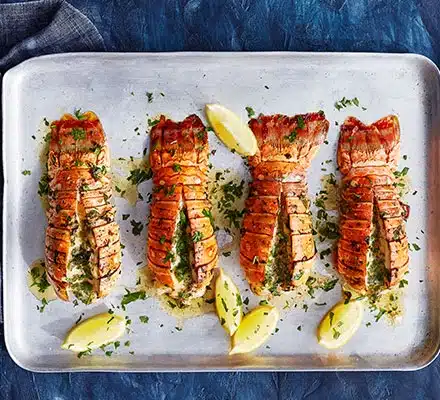Tips And Ways For Cooking Delicious Lobster Tail. A lobster tail is an edible meat that is located in the tail section of a lobster. It is considered a delicacy and is often served as an entrée in seafood restaurants.
Tips And Ways For Cooking Delicious Lobster Tail
Different Ways Of Cooking Lobster Tail
There are several different ways to cook lobster, each with its own unique flavor and texture. Some of the most common methods include:
- Boiling: This is one of the most popular methods of cooking lobster. The lobster is placed in a pot of boiling salted water for 8-12 minutes, or until the shell turns bright red and the meat is cooked through.
- Steaming: Similar to boiling, but the lobster is placed in a steamer basket over boiling water and steamed for 8-12 minutes. This method tends to be gentler and results in more tender meat.
- Baking: The lobster is placed in a baking dish, brushed with butter or oil, and baked in the oven at 425°F for 12-15 minutes. This method results in a slightly crispy exterior and a slice of moist, tender meat.
- Grilling: Lobster can be grilled on skewers or in halves, basted with butter or oil, and grilled for 5-8 minutes on each side.
- Broiling: Lobster can be split in half, brushed with butter, and broiled for 5-8 minutes.
- Sous vide: Lobster can be cooked in sous vide bath at a low temperature (around 140F) for 45 minutes to an hour.
- Deep frying: Lobster can be cut into small chunks or tails and deep-fried for 2-3 minutes until golden brown.
All methods result in a delicious and unique flavor, it depends on personal preference and the recipe you are following.
RELATED: How To Eat And Cook Oyster
Tips for the BEST Cooked Lobster:
- Start with high-quality live or freshly caught lobsters: Lobsters should be lively and active right before cooking. A dead lobster will not have the same taste and texture as a live one.
- Use the right amount of salt in the cooking water: Salt helps to enhance the natural flavor of the lobster and also helps the meat to cook evenly.
- Cook the lobster at the right temperature and for the correct amount of time: Overcooking or undercooking the lobster can result in rubbery or tough meat.
- Baste with butter or oil: Basting the lobster with butter or oil can add flavor and help to keep the meat moist and tender.
- Let the lobster rest before serving: Allowing the lobster to rest for a few minutes before serving will help to redistribute the juices and result in more flavorful meat.
- Serve with lemon wedges and butter: A squeeze of fresh lemon juice and a pat of butter can add a bright, acidic contrast to the rich, buttery lobster.
- Keep it simple, let the lobster be the star: Avoid overpowering the natural flavor of the lobster with too many spices or strong seasonings.
- Cook the lobster the same day you plan on eating it since the taste of the lobster will change after it has been cooked.
Nutrition
Lobster is a lean protein source that is low in calories and fat, making it a healthy addition to a well-balanced diet. A 3-ounce serving of cooked lobster contains about 84 calories, 1.5 grams of fat, 0.5 grams of saturated fat, and 17 grams of protein. It is also a good source of omega-3 fatty acids, which are essential for heart health, as well as vitamins and minerals such as vitamin B12, selenium, and phosphorus. Lobster is also a good source of zinc and copper.
However, it is important to note that lobster can be high in cholesterol and sodium content, so it should be consumed in moderation. It’s also important to take into consideration the cooking method and any added ingredients such as butter or oil that can increase the calorie and fat content.

